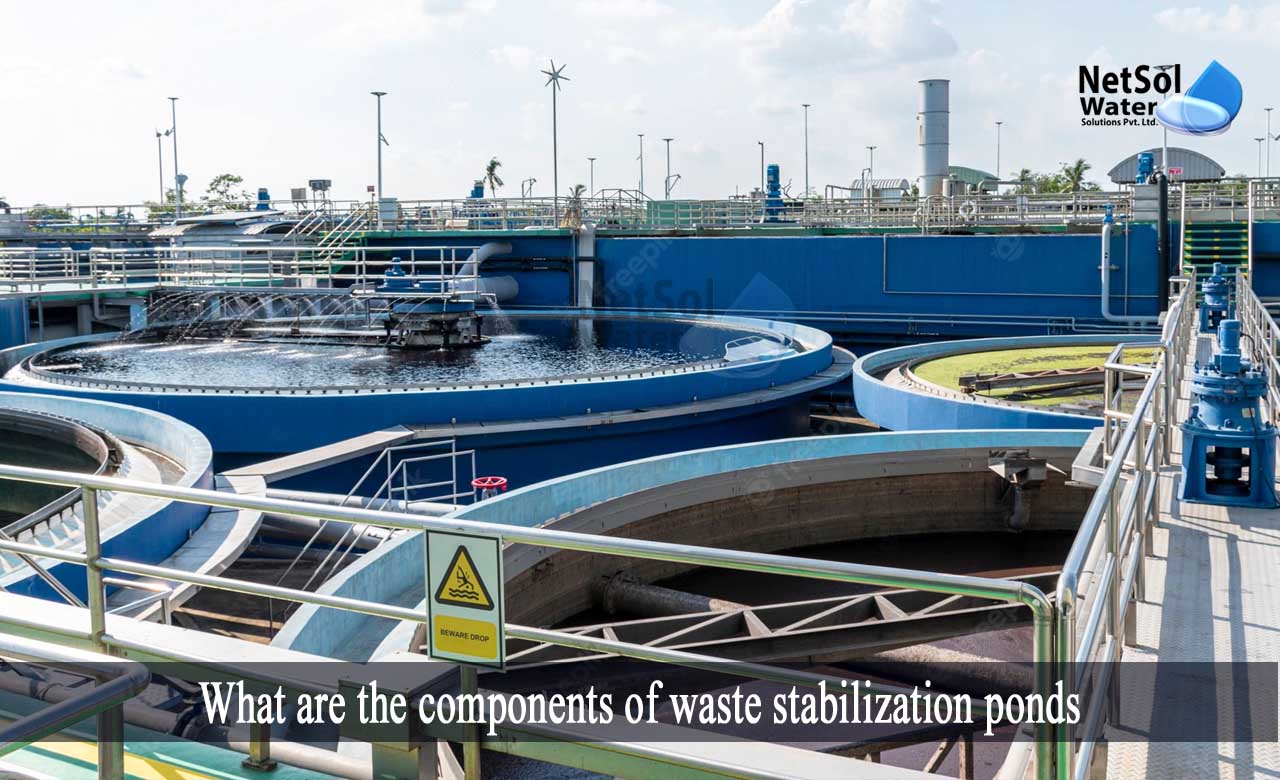What are the components of waste stabilization ponds?
WSPs, or waste stabilization ponds, are ponds that are planned and developed for wastewater treatment, in order to decrease organic content and eliminate pathogens.
The system may consist of a single pond or multiple ponds in sequence, with each pond serving a particular function in pollution removal. If the effluent fulfils the appropriate effluent criteria, it can be returned to surface water or utilized as irrigation water (or recovered water).
Waste stabilization ponds involve natural treatment processes that take time,because removal rates are slow.
Components of Waste stabilization pond(WSPs)
Waste stabilization ponds are man-made basins that contain a single or many stages of anaerobic, facultative, or maturation ponds. The presence or lack of oxygen changes, depending on the three types of ponds utilized in succession.
Since there is extremely little dissolved oxygen in anaerobic waste stabilization ponds, anaerobic conditions prevail. Facultative stabilization ponds, the second type of pond, support an aerobic surface habitat over an anaerobic benthic ecosystem. Maturation ponds provide aerobic conditions from the surface to the bottom.
What are anaerobic ponds?
Raw wastewater is fed into anaerobic ponds. They have a lower surface area and are deeper than facultative ponds. The depth reduces the impact of photosynthesis on oxygen generation, resulting in anaerobic conditions.These ponds may eliminate half to two-thirds of the influent BOD, depending on loading and climatic circumstances. This considerably reduces the organic matter load, which enters the facultative ponds, reducing their necessary size.
Working of anaerobic ponds
The first pond biome in a sequence of stabilization ponds, digests the suspended putrescible particles in the wastewater being treated. Solids sink to the bottom of anaerobic ponds as sludge. This settling process eliminates some of the particle organic material. A significant portion of the settled solids will collect around the point, where the wastewater enters the pond.
Sludge builds up at the bottom of anaerobic ponds and must be cleaned every few years.
What are facultative ponds?
Primary facultative ponds are raw wastewater facultative stabilization ponds. They are referred to as secondary facultative ponds, if they receive wastewater that has already been treated in anaerobic ponds. Other types of treatment methods, such as up-flow anaerobic sludge blanket (UASB) reactors, oxidation ditches, or aerated lagoons, may also employ facultative stabilization ponds for treatment.
These ponds are shallower and have a considerably bigger surface area than anaerobic ponds. The surface area is significant because it permits oxygen from the atmosphere to dissolve, and sunlight to reach the water. This enables photosynthetic activity, which creates more oxygen.
Working of facultative ponds
In most ponds, both bacteria and algae are required to enhance organic matter breakdown and pollution elimination. Algae create oxygen (photosynthesis) and consumes oxygen, but they leave a surplus of oxygen that aerobic bacteria can utilize for respiration, and the oxidation (or stabilization) of organic materials in the wastewater.
The sludge in the pond's sediment layer is digested anaerobically, and can collect for years without being removed.
What are Maturation ponds?
Maturation ponds must be shallow and have a large surface area, so that more oxygen may dissolve into the water and provide enough oxygen for the bacteria to work correctly. Shallow ponds benefit from increased photosynthetic activity caused by sun energy penetration.
Because of the strong photosynthesis, the pH levels are high, and UV radiation penetrates the higher layers. Both of these features help to eliminate harmful bacteria and viruses. Due to the large surface area of the maturation ponds, protozoan cysts and helminth eggs are also eliminated, primarily by sedimentation.
Conclusion
Waste Stabilization ponds are used globally for wastewater treatment, and are especially suited to warm-climate nations, like India. They are most commonly employed to treat sewage and industrial effluents, although they may also be used to treat municipal runoff or storm-water.
How can we assist?
Netsol Water is a well-known water treatment plant producer in India, offering a wide range of services including WTP manufacturing, WWTP manufacturing, STP manufacturing, ETP manufacturing, and much more. The firm develops and manufactures all-in-one systems for the treatment of wastewater and sludge.
In the best suitable treatment, we provide waste stabilization ponds which consist of facultative, maturation, or anaerobic ponds.Contact Netsol, if you have any questions regarding the appropriate sort of wastewater treatment facility for you. Any extra information you desire may be provided by a member of our technical sales team.
Netsol Water is Greater Noida-based leading water & wastewater treatment plant manufacturer. We are industry's most demanding company based on client review and work quality. We are known as best commercial RO plant manufacturers, industrial RO plant manufacturer, sewage treatment plant manufacturer, Water Softener Plant Manufacturers and effluent treatment plant manufacturers. Apart from this 24x7 customer support is our USP. Call on +91-9650608473, or write us at enquiry@netsolwater.com for any support, inquiry or product-purchase related query.



